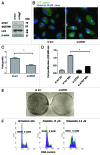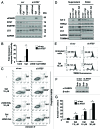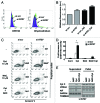Suppression of basal autophagy reduces lung cancer cell proliferation and enhances caspase-dependent and -independent apoptosis by stimulating ROS formation
- PMID: 22562073
- PMCID: PMC3429541
- DOI: 10.4161/auto.20123
Suppression of basal autophagy reduces lung cancer cell proliferation and enhances caspase-dependent and -independent apoptosis by stimulating ROS formation
Abstract
Autophagy is a catabolic process involved in the turnover of organelles and macromolecules which, depending on conditions, may lead to cell death or preserve cell survival. We found that some lung cancer cell lines and tumor samples are characterized by increased levels of lipidated LC3. Inhibition of autophagy sensitized non-small cell lung carcinoma (NSCLC) cells to cisplatin-induced apoptosis; however, such response was attenuated in cells treated with etoposide. Inhibition of autophagy stimulated ROS formation and treatment with cisplatin had a synergistic effect on ROS accumulation. Using genetically encoded hydrogen peroxide probes directed to intracellular compartments we found that autophagy inhibition facilitated formation of hydrogen peroxide in the cytosol and mitochondria of cisplatin-treated cells. The enhancement of cell death under conditions of inhibited autophagy was partially dependent on caspases, however, antioxidant NAC or hydroxyl radical scavengers, but not the scavengers of superoxide or a MnSOD mimetic, reduced the release of cytochrome c and abolished the sensitization of the cells to cisplatin-induced apoptosis. Such inhibition of ROS prevented the processing and release of AIF (apoptosis-inducing factor) and HTRA2 from mitochondria. Furthermore, suppression of autophagy in NSCLC cells with active basal autophagy reduced their proliferation without significant effect on the cell-cycle distribution. Inhibition of cell proliferation delayed accumulation of cells in the S phase upon treatment with etoposide that could attenuate the execution stage of etoposide-induced apoptosis. These findings suggest that autophagy suppression leads to inhibition of NSCLC cell proliferation and sensitizes them to cisplatin-induced caspase-dependent and -independent apoptosis by stimulation of ROS formation.
Keywords: NSCLC; ROS; apoptosis; autophagy; caspase-independent cell death; hydroxyl radical; superoxide.
Figures






Similar articles
-
Autophagy inhibition promotes 5-fluorouraci-induced apoptosis by stimulating ROS formation in human non-small cell lung cancer A549 cells.PLoS One. 2013;8(2):e56679. doi: 10.1371/journal.pone.0056679. Epub 2013 Feb 18. PLoS One. 2013. PMID: 23441212 Free PMC article.
-
Differential roles of hydrogen peroxide and hydroxyl radical in cisplatin-induced cell death in renal proximal tubular epithelial cells.J Lab Clin Med. 2003 Sep;142(3):178-86. doi: 10.1016/S0022-2143(03)00111-2. J Lab Clin Med. 2003. PMID: 14532906
-
Immunomodulatory proteins FIP-gts and chloroquine induce caspase-independent cell death via autophagy for resensitizing cisplatin-resistant urothelial cancer cells.Phytomedicine. 2016 Dec 1;23(13):1566-1573. doi: 10.1016/j.phymed.2016.09.003. Epub 2016 Sep 10. Phytomedicine. 2016. PMID: 27823620
-
Till Death Do Us Part: The Marriage of Autophagy and Apoptosis.Oxid Med Cell Longev. 2018 May 8;2018:4701275. doi: 10.1155/2018/4701275. eCollection 2018. Oxid Med Cell Longev. 2018. PMID: 29854084 Free PMC article. Review.
-
Autophagy, Metabolism, and Cancer.Cold Spring Harb Symp Quant Biol. 2016;81:73-78. doi: 10.1101/sqb.2016.81.030981. Epub 2017 Feb 16. Cold Spring Harb Symp Quant Biol. 2016. PMID: 28209717 Free PMC article. Review.
Cited by
-
High-temperature-required protein A2 as a predictive marker for response to chemotherapy and prognosis in patients with high-grade serous ovarian cancers.Br J Cancer. 2015 Feb 17;112(4):739-44. doi: 10.1038/bjc.2015.1. Epub 2015 Jan 27. Br J Cancer. 2015. PMID: 25628093 Free PMC article.
-
Systems biology: a way to make complex problems more understandable.Cell Death Dis. 2014 May 29;5(5):e1256. doi: 10.1038/cddis.2014.195. Cell Death Dis. 2014. PMID: 24874728 Free PMC article. No abstract available.
-
Global research and emerging trends in autophagy in lung cancer: a bibliometric and visualized study from 2013 to 2022.Front Pharmacol. 2024 Feb 27;15:1352422. doi: 10.3389/fphar.2024.1352422. eCollection 2024. Front Pharmacol. 2024. PMID: 38476332 Free PMC article.
-
Autophagy inhibition promotes 5-fluorouraci-induced apoptosis by stimulating ROS formation in human non-small cell lung cancer A549 cells.PLoS One. 2013;8(2):e56679. doi: 10.1371/journal.pone.0056679. Epub 2013 Feb 18. PLoS One. 2013. PMID: 23441212 Free PMC article.
-
BDH2 triggers ROS-induced cell death and autophagy by promoting Nrf2 ubiquitination in gastric cancer.J Exp Clin Cancer Res. 2020 Jun 30;39(1):123. doi: 10.1186/s13046-020-01620-z. J Exp Clin Cancer Res. 2020. PMID: 32605589 Free PMC article.
References
-
- Pyo JO, Nah J, Kim HJ, Lee HJ, Heo J, Lee H, et al. Compensatory activation of ERK1/2 in Atg5-deficient mouse embryo fibroblasts suppresses oxidative stress-induced cell death. Autophagy. 2008;4:315–21. - PubMed
Publication types
MeSH terms
Substances
LinkOut - more resources
Full Text Sources
Other Literature Sources
Medical
